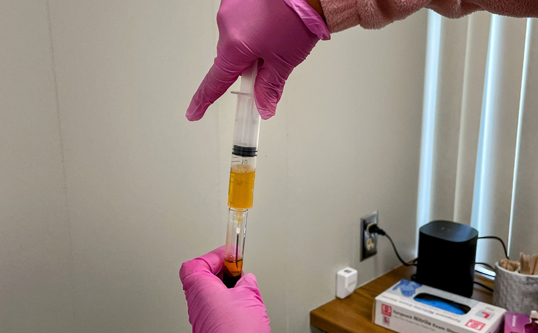Platelet Rich Plasma (PRP): What Is It and How Can It Help You?
Platelet-rich plasma therapy is a form of regenerative medicine that harnesses and amplifies the natural growth factors found in our blood cells to help heal damaged tissue. PRP has been effectively used to treat various soft-tissue injuries and joint conditions, including knee pain, Achilles tendinitis, arthritis in multiple joints, damaged vertebral discs, and muscle tears. In today’s sports medicine, several sports injuries in both professional and recreational athletes can now be successfully treated using PRP.
How Is Platelet-Rich Plasma (PRP) Produced?
PRP is produced from a person’s own blood. It consists of a concentrated form of one type of blood cell, platelets, which are critical for blood clotting. This concentration is injected into an injured or diseased part of the body to accelerate the healing of damaged tendons, ligaments, muscles, bones, and joints.
A key advantage of PRP injections is that they can reduce the need for opioids or even over-the-counter anti-inflammatory medications. In fact, the use of anti-inflammatories should usually be ceased at the time of PRP treatment because the platelet-rich plasma optimizes the initial inflammatory response involved in healing.
- PRP consists of two key components: plasma, which is the liquid portion of blood, and platelets.
- Beyond clotting, platelets contain growth factors that play a crucial role in healing throughout the body.
- PRP is essentially the clear liquid part of our blood that contains a higher concentration of platelets than usual.
- To create PRP, clinicians take a blood sample from the patient and use a centrifuge to separate out the platelets, concentrating them within the plasma.
How Does PRP Treatment Work?
After obtaining PRP from the patient’s blood, a clinician injects it into a specific target area, such as an injured knee or tendon. In some cases, clinicians use ultrasound guidance during the injection. The goal is to increase the concentration of growth factors in that area, thereby accelerating the healing process. While the exact mechanism behind PRP injections isn’t fully understood, studies suggest that the increased growth factor concentration can shorten healing time, reduce pain, and even promote hair growth.
Applications of PRP Treatment:
- Musculoskeletal Injuries: PRP injections are used to treat various musculoskeletal conditions, including chronic tendon injuries like tennis elbow, Achilles tendinitis, Hoffa’s syndrome or jumper’s knee, hip flexor tendinitis, hamstring strains and tears, rotator cuff tendinitis and tears, and many more. By stimulating healing and reducing pain, PRP can aid in a quicker return to activities.
- Aesthetic Procedures: PRP is also employed in aesthetic treatments. It can address male pattern baldness, enhance hair transplant results, and complement other treatments such as microneedling with PRP for skin rejuvenation.
- Sexual Rejuvenation Therapy: PRP is also used for male sexual rejuvenation (P-shot) and female rejuvenation (O-shot) treatments. The results from these treatments can last for years.
Results and Considerations:
The effects of PRP treatment are noticeable after only a couple of weeks for most soft tissue injuries. Usually, only a single injection is needed for complete recovery. Based on experience, most patients who underwent PRP sexual regeneration therapy reported the effects of the treatment within days to a few weeks. Since PRP uses a patient’s own blood, it is relatively safe, with very minimal potential for complications. As with any injection, there is a remote risk of infection and minor bleeding.
In conclusion, PRP therapy harnesses the body’s natural healing powers, making it an excellent choice in sports and regenerative medicine. Dr. Roland Kafuuma, MD, at Aesthetics and Medical Lasers of Colorado, specializes in PRP regenerative medicine treatments. The clinic has locations in both Longmont and Fort Collins, Colorado. For more information, contact the clinic at 720-818-0533


